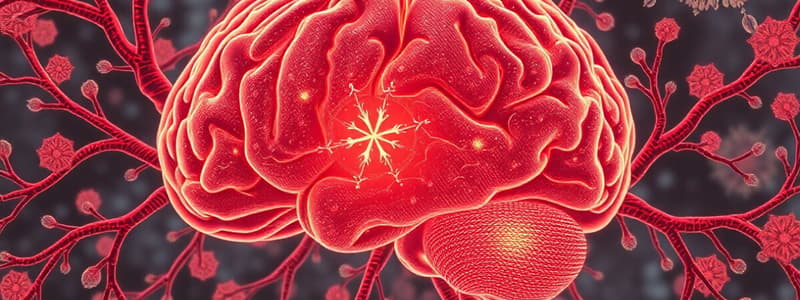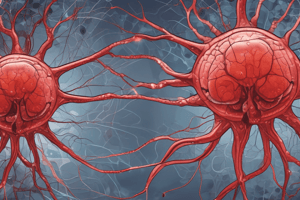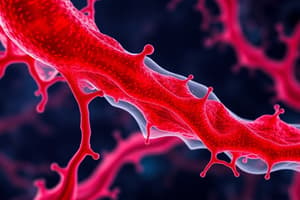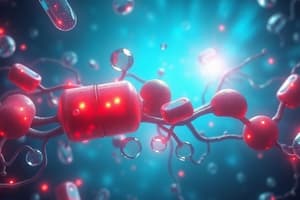Podcast
Questions and Answers
Why is the attrition rate of new drugs directed at the central nervous system (CNS) higher compared to other therapeutic areas?
Why is the attrition rate of new drugs directed at the central nervous system (CNS) higher compared to other therapeutic areas?
- CNS drugs are inherently more toxic than drugs for other systems.
- The blood-brain barrier (BBB) restricts the entry of chemical entities into the brain. (correct)
- There is less funding available for CNS drug development.
- CNS drug targets are less well-validated.
What is the primary challenge in developing in vitro models of the blood-brain barrier (BBB) for pharmaceutical industries?
What is the primary challenge in developing in vitro models of the blood-brain barrier (BBB) for pharmaceutical industries?
- Achieving high throughput screening while maintaining fundamental BBB characteristics. (correct)
- Reducing the cost of cell culture media.
- Simplifying the complexity of the neurovascular unit.
- Eliminating the need for animal testing.
Which of the following is NOT a component of the neurovascular unit?
Which of the following is NOT a component of the neurovascular unit?
- Astrocytes
- Cerebral endothelial cells
- Hepatocytes (correct)
- Neurons
How do astrocytes contribute to the functionality of the blood-brain barrier (BBB)?
How do astrocytes contribute to the functionality of the blood-brain barrier (BBB)?
What is the role of efflux transporters, such as P-glycoprotein (P-gp), in cerebral endothelial cells (CECs)?
What is the role of efflux transporters, such as P-glycoprotein (P-gp), in cerebral endothelial cells (CECs)?
What is a key characteristic of cerebral endothelial cells (CECs) that distinguishes them from peripheral endothelial cells?
What is a key characteristic of cerebral endothelial cells (CECs) that distinguishes them from peripheral endothelial cells?
What is the primary function of tight junctions (TJs) in cerebral endothelial cells (CECs)?
What is the primary function of tight junctions (TJs) in cerebral endothelial cells (CECs)?
In the context of drug transport across the blood-brain barrier (BBB), what does the term 'molecular Trojan horse' refer to?
In the context of drug transport across the blood-brain barrier (BBB), what does the term 'molecular Trojan horse' refer to?
What is the general principle behind the Parallel Artificial Membrane Permeability Assay (PAMPA) used for assessing BBB permeability?
What is the general principle behind the Parallel Artificial Membrane Permeability Assay (PAMPA) used for assessing BBB permeability?
What is a limitation of using immortalized cell lines as in vitro models of the BBB?
What is a limitation of using immortalized cell lines as in vitro models of the BBB?
Flashcards
What is the BBB?
What is the BBB?
The bottleneck in developing drugs for the central nervous system (CNS) due to its hindering access to the brain.
What is the BBB?
What is the BBB?
Composed of cerebral endothelial cells (CECs) that delimit cerebral microvessels and maintain CNS homeostasis.
What connects CECs?
What connects CECs?
Adherens junctions (AJs) and tight junctions (TJs).
How do molecules cross the BBB?
How do molecules cross the BBB?
Signup and view all the flashcards
What is the role of P-glycoprotein (P-gp)?
What is the role of P-glycoprotein (P-gp)?
Signup and view all the flashcards
What are Astrocytes?
What are Astrocytes?
Signup and view all the flashcards
What are Pericytes?
What are Pericytes?
Signup and view all the flashcards
What is PAMPA?
What is PAMPA?
Signup and view all the flashcards
What are advantages of in vitro models?
What are advantages of in vitro models?
Signup and view all the flashcards
What is the use of imaging (e.g. MRI, PET, SPECT)?
What is the use of imaging (e.g. MRI, PET, SPECT)?
Signup and view all the flashcards
Study Notes
- During CNS drug research, considerable drug candidate loss occurs due to hampered brain access by the blood-brain barrier (BBB)
- The goal is to develop BBB models that retain fundamental characteristics while meeting pharmaceutical industry demands
- A review describes the roles of the neurovascular unit elements, their influence on brain penetration, in vitro/vivo models
- Addresses their contribution to enhancing brain drug delivery and transport
BBB and Neurovascular Unit
- Molecular exchanges between the blood and neural tissue are restricted by the blood-CSF barrier, arachnoid barrier, and BBB
- Cerebral endothelial cells (CECs) form the BBB, crucial for blood-CNS exchange and CNS homeostasis regulation
- The neurovascular unit contains CECs, astrocytes, pericytes, microglia, neurons, and extracellular matrix
- This coordinated system regulates cerebral microvascular permeability, impacting drug penetration
Cerebral Endothelial Cells (CECs)
- CECs constitute a selective barrier covering the inner surface of cerebral capillaries, determining BBB permeability
- CECs differ from peripheral endothelial cells by not having fenestrae, exhibiting low pinocytotic activity, and having more mitochondria
- CECs poses interconnections between adjacent cells, namely adherens junctions (AJs) and tight junctions (TJs)
- AJ cadherin proteins mediate CEC adhesion, cell polarity, and regulate paracellular permeability
- TJs occlude the intercellular cleft by forming a multi-protein complex composed by transmembrane proteins and cytoplasmic proteins
- Limited ion movement yields higher trans-endothelial electrical resistance (TEER) in brain endothelium
- Anionicity is another determinant factor of BBB permeation
- Gaseous and lipophilic molecules use passive transcellular diffusion, while nutrients use solute-carrier transporters (SLC)
- Large molecules cross via receptor-mediated transcytosis (RMT)
- Cationized proteins are carried by adsorptive-mediated transcytosis (AMT)
- Efflux carriers like P-glycoprotein (P-gp) mediate lipophilic compound efflux
- Other ABC protein family members include multidrug resistance-associated proteins ABCG2
- Role of ABCG2 on drug efflux remains debated
- CECs form a metabolic barrier via enzymes like alkaline phosphatase (AP) and cytochrome P450 (CYP)
Astrocytes
- Astrocytes closely interact with CECs, ensuring neuronal function and controlling cerebral blood flow
- Astrocytic end-feet cover CECs, maintaining tight junctions,enzyme systems and transporter location
- Properties influencing BBB maturation include glial fibrillary acidic protein, orthogonal arrays of particles (OAPs)
- OAPs contain potassium channel kir4.1 and water channel aquaporin-4 (AQP-4)
- Accumulation of heparin sulfate proteoglycan(agrin) supports BBB integrity
- Matrix adhesion receptors contribute to BBB properties
Pericytes
- Pericytes stabilize small vessels and influence angiogenesis
- Pericyte loss causes abnormal vascular morphology, endothelial hyperplasia, and permeability increase
- Pericytes regulate BBB-gene expression patterns and astrocyte end-feet polarization
- Brain pericytes are directly or indirectly involved in CNS pathologies
Microglia
- Microglia, also known as cerebral perivascular macrophages, control immune responses and regulate paracellular permeability
In Vitro BBB Models
- In vitro models are required to possess low paracellular permeability and express key enzymes with carrier systems
- In vitro models with as many BBB characteristics that remain time-practical and feasible for high-moderate-throughput screening
- No specific in vitro BBB model has been adopted by pharmaceutical industries as the "gold standard"
- Current strategy should use combined approaches with distinct in vitro models should be applied for rationalizing and optimizing with brain penetration during CNS studies
- High throughput capacity, lower cost, direct quantification of compounds in physiological buffer, early identification of cell toxicity, and few animals for testing
Surrogate Models
- Parallel Artificial Membrane Permeability Assay, enables the prediction of gastrointestinal absorption
- Modified PAMPA models can differentiate BBB crossing compounds using lipid solutions
- Porcine brain lipids (PBL) mimic blood-brain barrier
- Artificial lipid membranes do not include influx or efflux to BBB
- PAMPA shows high power for predicting BBB permeability of passive diffusion across BBB
Cell-Based Models
- Mimic the BBB, begins with isolation of brain capillaries, culture cells mimic BBB is in vitro
- Cells of non-cerebral origin or cells from primary are used in monoculture, coculture, and triple cell cultures
- Lack if exposure to physiological conditions may result in differing relevant cell biological transporters ligands etc.
- In vitro, permeability assays are carried out in multi-well plates, that stimulates contact with different media in compartments
- Polycarbonate used for permeability studies of hydrophilic and lipophilic
- The permeability by paracellular diffusion of compounds.between endothelial cells must be limited by TJs in order to make the model discriminative
Techniques
- Transendothelial Electrical Resistance used voltage-measuring electrode is placed in each compartment, the resistance data read in the apparatus
- Need to have a sufficient the high TEER value, and a low apparent permeability for the specific molecules uses for integrity markers to evaluate the cell monolayer to be considered adequate to be used
- Commonly use cell culture medium to control tight junction level
Non-Cerebral Cells
- Mammalian kidneys,Madin-Darby Canine Kidney the most commonly used
- Easy to grow compared to CEC are most frequently transferred to multidrug resistance one gene order for polarity The expression of B-gp and subsequent influence of the P-gp flow through The BBB model.
- Caco-2: not commonly used compared to BBB cells
- It was also considered more discriminatory than other in vitro models including primary Bovine one and human CCC line co cultured with astrocytes
- A red and Mouse as immortalized cell line and other non cereal cells
In Vivo Methods
- Better understand the biology but have low throughput capabilities used in more advanced phases
- Among the several in vivo studies, the key concepts used for estimating the ability of a drug to overpass BBB include the rate of BBB permeation and the extent of equilibration.
- The extent depends passive diffusion
Types
- In Situ brain perfusion, involves carotid perfusion animal decapitated, but cannot circumvent metabolism from microcirculation
- Brain uptake index, involves bolus, inject radio labeled, the test into common catarrhal and or the animal decapacitated. Quick and and therefore potential efflux
- Intravenous injection technique, involved in cannulation of femural/tail- vein plasma collect blood example the assessment
- Intra cerebral microdialysis complex non clean need to calculate any of the samples but reduce number animals for kinetics investigation
Drug Delivery to the CNS
- Treatment of CNS disorders includes delivery of molecules with properties safely across the BB - include diseases and deficiencies associated with development for treatment that makes development a urgent challenge
- Several strategies have temporarily disrupt. - drug transport temporary destruction. - drug chemical. - combination and nanoscale drug all to aid delivery
- Disruption is a transient increase permeability, the brain
- Causes can be modified
Let me know if you'd like any changes or refinements to this summary!
Studying That Suits You
Use AI to generate personalized quizzes and flashcards to suit your learning preferences.




